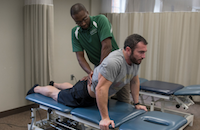
Physical therapy as an alternative to opioid use in pain management has gained national attention as more light shines on addiction, overdose and death due to opioids.
The month of September is recognized in the United States as National Alcohol and Drug Addiction Recovery Month with the goal of raising awareness of the gains made by those who identify as being in recovery and attention to the needs of those in recovery.
Prior to the intense marketing and production of opioids by pharmaceutical companies, pain clinics were more multi-faceted in their approach to pain management and often included physical therapy. According to Betty Sindelar, associate professor in CHSP’s School of Rehabilitation and Communication Sciences, once opioids started to take hold as an “easier” method of pain management, clinics moved away from using physical therapy as often. With the dangers of opioids now obvious, physical therapy is again being recognized as an effective component of pain management.
Physical therapy works most effectively in pain treatment when therapists can interact with a patient early in the process. With some medical conditions, pharmaceuticals may not be necessary. In others, physical therapy can be used in conjunction with medication. Physical Therapist Manager Tara Legar said Ohio University Therapy Associates wants to see people before they start taking medication regularly. Otherwise, weeks may pass with the patient moving incorrectly, or not at all, which makes recovery that much more difficult. Sindelar added that patient education is key.
“With chronic pain, the feedback mechanism for patients has gone haywire,” she said. “Normally with pain, if you touch something hot, you pull away. It’s protective. With chronic pain, it’s no longer protective yet it continues. It’s a matter of education that the pain is no longer protecting you and we have to get you moving. We do that in incremental stages and you can get people back to being productive.”
In certain cases, such as a knee replacement surgery, opioid use is appropriate, according to Legar, since without the medication it would sometimes be too difficult for the patient to move to begin physical therapy. Physical therapy treatments such as dry needling — the use of fine needles to release or inactivate trigger points to relieve pain in muscles — and traditional movement rehabilitation are non-addictive.
Through its partnership with OhioHealth, CHSP’s OUTA is working to implement screenings to give patients a physical therapy evaluation early in the treatment process and create a stronger healthcare plan as a team.